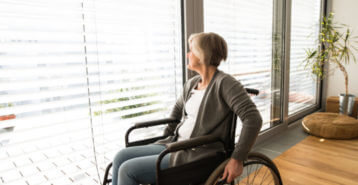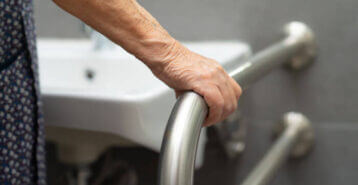Are you doing a home improvement project?
Modernize can pair you with three to four pros in your area, so you can compare options and save time and money.
As people grow older, it makes sense that they begin thinking about whether they want to age at home, or look into assisted living options. For many homeowners, staying put in a comfortable, familiar home while entering the golden years sounds very appealing. In fact, 76% of respondents to a 2018 AARP survey said they prefer the idea of aging in place. However, about a third of them felt as though their home would need major home accessibility modifications to make this happen.
Modifications can definitely make life easier for those who want to stay in their homes as long as possible. But it is also important to keep in mind that the home itself is just one of the many factors to consider when deciding whether aging in place is a good idea for you or your loved one.
What is Aging in Place?
Aging in place simply means choosing to live in one’s home as they grow older, rather than relocating to an assisted living arrangement. Both of these are feasible options for seniors of any age. The best decision for you or your loved one depends on many different factors.
Many seniors prefer aging in place because they want to retain their independence and level of comfort. Homes are often filled with cherished memories, familiar surroundings, and comfortable routines. Luckily, in this day and age, many senior homeowners now have the option to remain at home as they age through home accessibility modifications. Some of these modifications and home improvements include stair lifts, medical alert devices, and medical alert devices, among others.
What Makes Aging in Place Possible
Remember, when thinking about whether aging in place is right for you or your loved one, it is not just about the house. It’s also the person themselves, and the community around them. That community can include family, friends, groups of peers, supportive services in that community, the medical facilities and professionals they turn to for help, and so much more.
Regardless of whether you are making the decision for yourself or for someone else, you will probably want to talk through some important points with your loved one(s). Spend some time with your loved one and look at the following points:
- What does their routine like?
- Are there activities they struggle to do?
- What does their house look like?
- What kind of social support do they have?
- Is reliable transportation in place?
There might be other points to ponder, depending upon you or your loved one’s situation. After making a thorough assessment of these situations, it’s time to have a discussion about the possibility of aging at home. First, talk with a physician. He or she might be able to tell you what to expect in the coming years, especially with various medical conditions a person may have. Then, speak with your loved one about their preferences for their future.
To learn more about the considerations for aging in place, look to the National Association of Area Agencies in Aging to find local information.
Remember, do not be surprised at all if your loved one balks at the idea of even discussing moving out of their home. This can be a very sensitive subject. Keep the first discussion short and gentle. In most cases, this will be a process, not an immediate, emergency situation.
Find the Right Contractor for Your Project
Whether you’re ready to begin your project now or need some expert advice, our network of contractors are here to help. With a few simple questions, we’ll find the best local professionals for you
When an Assisted Living Facility is Best
Sometimes, the solution will be very clear. Keep in mind that poor health does not necessarily mean a person needs to be in a nursing facility or assisted living. However, that combined with other factors could necessitate the move.
Here are some important factors to consider that may indicate an assisted living environment may be best for your loved one:
- The only family caregivers live far away.
- Your loved one isn’t happy having strangers in the home.
- You are in poor health, need to work full-time, have small children, or otherwise have your own family obligations that make it tough to become a caregiver.
- Your loved one doesn’t have good emotional support (and perhaps you don’t either).
- The home requires modifications that are not financially feasible.
- The home is far too small to house a caregiver, or medical equipment and supplies.
- Your loved one is isolated, feels lonely or depressed, and misses the company of others.
- The transportation options in the area are sorely lacking.
Keep in mind that sometimes, your intuition will tell you what you need to know. It might seem as though your loved one is just fine at home, but there might be something that is just not right. Pay attention to that gut feeling.
Potential Home Modifications for Aging in Place
Unfortunately, many homes today were not built with aging in place in mind. Many homes have stairs, standard bathroom and kitchen fixtures, doorways and hallways that are less than the 36 inches in width necessary to accommodate a wheelchair. But fortunately, some homes lend themselves well to aging in place designs and modifications. Here are a few options:
- Walk-in tub or shower. These can often fit into the same footprint as the existing shower or tub. Explore additional accessible bathroom modifications.
- Grab bars. Sturdy bars attached to studs in the wall can help prevent falls.
- Continuous handrails. These are a must for stairs, but can also be helpful in hallways.
- Lights. Bright lights throughout the home, touch lamps, battery powered motion sensor lights, nightlights, and light switches at both ends of a hallway promote safety.
- Lever door handles. These can replace those tough-to-use rotation knobs.
- Extra shelves. Install extra kitchen and bathroom shelves low enough to avoid the strain and danger of reaching for items on a high shelf.
- Stair lift. Homes with a staircase can benefit from this safety feature.
- Ramps. Gently sloping ramps over the existing stairs can help reduce fall risks.
How Technology Can Help
Technology is advancing rapidly, and that includes new and innovative tools to keep seniors safe and in their homes longer. For instance, remote activity monitoring can be a helpful tool for the long-distance caregiver, as sensors can immediately alert them to something amiss in their loved one’s home.
Here are a few options:
- Smart home sensors. Embedded sensors in the home can control the temperature, detect smoke or carbon monoxide, turn on lights when someone enters a room, and collect data on various points in the house, such as when a door is opened.
- Smart appliances. Some appliances work seamlessly with a smart home to promote safety, such as turning off the oven after a certain period of time or alerting loudly if the refrigerator is left open.
- Personal emergency response systems. Known as PERS, these medical alert systems can take a variety of forms, but among the most common is a pendant or wristband worn at all times. It can detect falls and send an immediate alert to a central monitoring service, a caregiver’s phone, or anywhere else that you’ve programmed into the system, or can allow the user to press a button to ask for help in an emergency.
- Video monitoring. These are small, unobtrusive home security systems placed in various points throughout the home that send real-time recordings to a caregiver’s laptop or smartphone. This can allow you to check in at any time during the day to see how your loved one is doing.
- Telemedicine. If getting to the doctor on a regular basis is a hassle, telemedicine can help. This is a great option for those who have limited transportation or find getting out of the house difficult.
- Medication reminders. Usually in the form of an app, these reminders can alert the user to times to take medication, as well as alert the caregiver through text.
- Wearable sensors. These sensors clip onto clothing or are worn as a watch. They monitor things like heart rate and blood pressure, and can transmit those readings to an app.
Finding the Right Aging in Place Professional
Though many professionals can handle the smaller jobs that make a home more accessible, such as installing a walk-in tub or building ramps, some contractors have a keener sense of what a home will need to allow residents to live there into their golden years. These experts are known as Certified Aging in Place Specialists, or CAPS. They can earn this designation from the National Association of Home Builders.
To find a great aging in place specialist for you or your loved one, look to Modernize for help. When you’re ready to make those changes that will allow you or your loved one to age at home, we can help connect you with a professional.
Find the Right Contractor for Your Project
Whether you’re ready to begin your project now or need some expert advice, our network of contractors are here to help. With a few simple questions, we’ll find the best local professionals for you
Reviews from Real Homeowners
Welcome to Homeowner Resources! We are the Modernize blog. Modernize pairs more than 3 million homeowners a year with pre-vetted contractors in their area. This blog started because we believe homeowners should know everything about their homes, from how their HVAC works to which front door colors they might love. On Homeowner Resources, you can find information on every part of your home, right down to how you can negotiate with contractors to get the best price. Here's more about the blog.
Need a contractor? Learn more about how Modernize finds the right pro for you.




